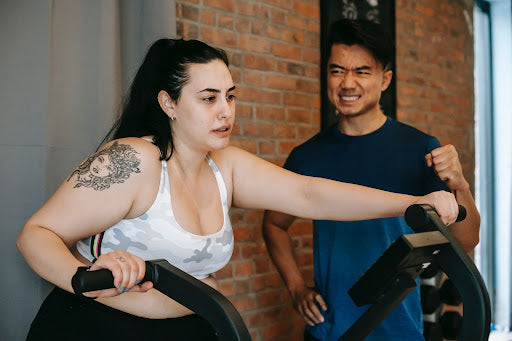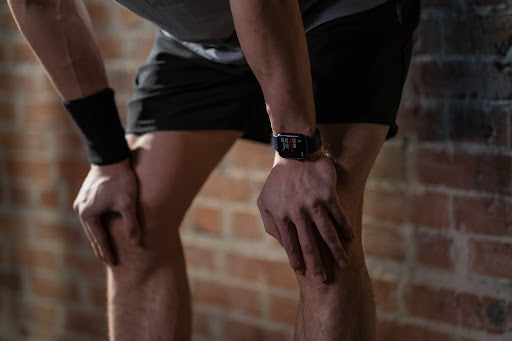Have you ever thought of looking for a new workout outside of your gym grind? Do you find yourself unable to carve out enough in your schedule to be at the gym for hours every day? Many people struggle to incorporate gym time into their busy lives, and it’s easy to fall into a workout rut. HIIT exercise is customizable, effective, and easy to do from home, making it a simple solution to your workout woes.
HIIT or high-intensity interval training is a form of exercise that alternates between extreme segments of physical activity and periods of rest. HIIT workouts have been proven to provide better results for people trying to lose weight and gain muscle simultaneously.
HIIT aims to increase your heart rate to a certain level, allowing you to burn fat hours after you finish. The best part about HIIT workouts is their efficiency; they take an average of 30 minutes or less and can be completed in your own home. Read on to learn more about what goes into a proper HIIT workout!
How Do HIIT Workouts Work?
The main distinction between HIIT workouts and traditional endurance exercises is HIIT’s ability to burn more calories, even after you complete your daily training. HIIT workout participants can burn excess calories after finishing their exercise because of the shortened rest periods that limit their bodies in between sets of aerobic exercises. Studies show that during HIIT training, your body also does a better job of maintaining the muscle you’ve already constructed while burning the maximum amount of fat.
In general, the recovery periods are supposed to last as long as the exercise periods. The aerobic exercises can range from cycling to cross-training to swimming, among many others. Any exercise can be part of a HIIT workout if you can maintain 80 percent to 95 percent of your estimated heart rate, which is about the highest it can be without overworking yourself.
Length of HIIT Workouts
Although most dedicated gym-goers will notice positive physical results, HIIT workouts can benefit your body more efficiently while providing similar, if not better, outcomes. On average, a HIIT workout lasts for 30 minutes, but some of the shortest sessions can be as quick as four minutes!
A HIIT workout is the perfect match for somebody who doesn’t have time for a longer workout or who struggles to make it to the gym every day. Even if you can fit long gym sessions into your schedule, this alternate form of exercise is a much easier way to remain committed to working out because it’s a type of training that you can work around your schedule.
Convenience
Not only are HIIT workout routines easy to fit into your schedule, but they can also be done in the convenience of your own home. Because HIIT workouts heavily rely on plyometric exercise to raise your heart rate, you can perform them in plenty of spaces that don’t require a gym membership. You can complete any of these vigorous training exercises in the space of your own home, with little to no equipment necessary.
Although machines aren’t required for HIIT workouts, they certainly can be used if you’re interested. For example, take a look at the new SKI-ROW AIR dual function HIIT machine from EnergyFit, which has received universally positive reviews.
This two-in-one machine functions as a rower and a ski trainer with a simple 5-second switch mechanism, and it’s designed to comfortably fit inside your living space. This machine is easy to assemble, and it allows users to connect their heart-rate monitors to the console.
Benefits
HIIT workouts are becoming extremely popular due to their convenience, their practicality, and their physical results. After you finish your workout, your body will continue to burn fat for hours. This occurs due to Excess Post-exercise Oxygen Consumption (EPOC), a process that increases the amount of oxygen consumption in your body following a successful HIIT workout to burn fat nine times faster.
Aside from burning fat and calories, these workouts stimulate anabolic hormones and construct lean muscle. HIIT can more efficiently help your body build and maintain muscle mass while simultaneously burning fat.
Overall Health
Along with the many physical benefits like helping you burn calories, HIIT workouts can improve your overall appearance and have a long-lasting effect on your health.
Weight Loss
When trying to lose weight, many people will attempt to build lean muscle tissue while burning excess fat.
HIIT forces your body to use energy from fat instead of carbs, making it easier to maintain existing muscle while trimming down excess fat. This workout can boost your metabolism, as well. HIIT can be highly effective for fat loss in those who are overweight or obese. HIIT may also help to lower blood sugar and improve insulin sensitivity.
By increasing Human Growth Hormone (HGH) during and after your HIIT training sessions, your metabolic rate goes up. That’s why you burn more calories during a HIIT workout than a normal cardio exercise, and your body will continue burning fat for up to 24 hours after your training.
This is why HIIT is a more effective weight loss method than typical gym exercises.
Heart Health
People who participate in HIIT exercises will consistently push themselves to their anaerobic zone (80% of your estimated heart rate), strengthening their oxygen intake and reinforcing their heart. HIIT workouts have also been known to reduce blood pressure, reduce blood sugar levels, and lower heart rates. People who dedicate themselves to a heart-healthy lifestyle may reduce the odds of a stroke or heart attack.
You are never too old to start caring for your heart health. By developing good habits like HIIT workouts, you can help reduce your risk of a heart attack, even if you’ve already experienced a heart attack previously.
These intensely productive workouts have even been proven to reverse signs of cellular aging through your body’s ability to produce and synthesize proteins.
Types of High-Intensity Exercises
HIIT’s increased resting metabolic rate can aid weight loss and build stronger muscles in less time than a typical workout.
Types of HIIT exercises include:
- Squats
- Squat Jumps
- Pushups,
- Strength endurance exercises like kettlebell swings
- High Knees, jump lunges
- Sprints
- Rowing machines
- Skiing machines
Conclusion
Don’t settle for the gym. HIIT workouts are a wonderful, practical alternative to an average gym session because they are more effective, more efficient, and more enjoyable. HIIT workouts are the obvious choice for your fitness goals, with health benefits ranging from an increased metabolic rate that aids weight loss to decreased blood pressure and blood sugar.
HIIT training isn’t extremely different from what you would normally do at the gym, and it’s not more difficult than your typical gym exercise, either. The added rest periods simply boost your oxygen consumption levels post-workout and allow you to burn more fat while simultaneously building muscle.
HIIT workouts are extremely convenient and practical. They can be completed using your favorite cardiovascular exercises, and they do not require a ton of equipment or a gym membership.
HIIT workouts generally last for a half-hour, and you can workout from the comfort of your own home. Just one piece of home equipment like the SKI-ROW is enough to provide a lifetime of HIIT workout options, making your HIIT session interesting and fun.
Sources:
Benefits of HIIT Workouts | YMCA of Greater Cincinnati
High-Intensity Interval Training | American College of Sports Medicine
8 Promising Benefits to HIIT Workouts That Will Make You Want to Start Right Now! | Lifehack





Leave a comment
All comments are moderated before being published.
This site is protected by hCaptcha and the hCaptcha Privacy Policy and Terms of Service apply.